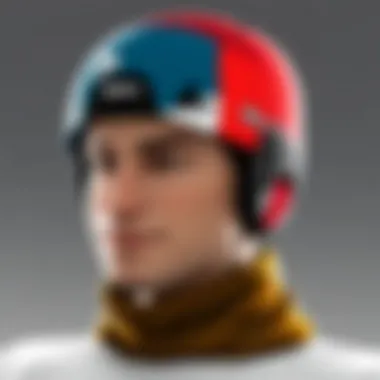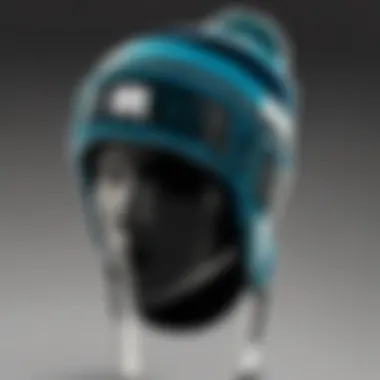Understanding Snowboard Helmets and Beanies Guide


Intro
Understanding the nuances of snowboard helmets and beanies is critical for anyone involved in winter sports. As snowboarding becomes more popular, the safety gear necessary to protect enthusiasts has evolved significantly. This guide will look into the essential features of helmets and beanies, detailing materials used and safety standards in the industry.
Snowboard helmets are designed primarily for safety, offering crucial head protection while riding down slopes. Their structure often includes hard outer shells made from impact-resistant material, along with inner foam for cushioning. Beanies, on the other hand, are often chosen for warmth and style rather than safety. This guide will emphasize the importance of selecting the right gear based on personal preferences and environmental conditions.
The conversation around snowboard gear cannot ignore the trends in design which merge functionality with personal expression. Aesthetics play a significant role in snowboard culture, influencing choices beyond just safety. Throughout this guide, insights on how to navigate these choices and consider safety standards will be provided.
Prologue to Snowboarding Safety
Snowboarding is an exhilarating sport, drawing many to the mountains each winter. However, it comes with inherent risks. Understanding snowboarding safety is essential for anyone involved in this sport. The significance of head protection cannot be overstated. Injuries can occur in a split second, making it crucial to prepare adequately. Safety gear, particularly helmets and beanies, plays an integral role in minimizing risks.
The Importance of Head Protection
Head injuries are among the most serious risks faced by snowboarders. In falls, collisions, or accidents, a helmet can be the difference between a minor scare and a life-altering injury. Snowboard helmets are designed to absorb impact and prevent penetrating injuries. This protective gear is a vital consideration for every rider, whether a novice or an expert.
Research indicates that wearing a helmet significantly reduces the risk of head injuries. The American Academy of Pediatrics suggests that children and adults should consistently wear helmets while engaging in snow sports.
Key points regarding helmet use include:
- Impact Absorption: Helmets are crafted to diminish the force of impacts.
- Visibility: Many helmets come with bright colors or reflective surfaces, enhancing visibility on the slopes.
- Comfort and Fit: A well-fitting helmet promotes comfort and encourages consistent use.
Overall, equipping oneself with a dependable helmet enhances safety and instills confidence on the slopes.
Overview of Common Injuries
Despite taking precautions, snowboarders still encounter several types of injuries. Understanding these common injuries is important for recognizing potential risks while snowboarding. Some prevalent types of injuries include:
- Concussions: Often resulting from falls or collisions. Symptoms may include confusion, dizziness, and headache.
- Fractures: Wrists, arms, and collarbones are frequently fractured in falls. Proper technique and protective gear can mitigate these injuries.
- Sprains: Ligament injuries, like ankle sprains, are common as snowboarders twist or land incorrectly.
Injury prevention goes hand in hand with understanding these risks. Engaging in lessons, practicing technique, and using protective equipment can greatly reduce the likelihood of suffering from these common issues.
"Safety first. Always remember, your head is more important than any trick you want to attempt."
Snowboard Helmets: A Technical Overview
Snowboard helmets serve a crucial function in ensuring the safety of riders on the slopes. Understanding their technical aspects can significantly influence the choice of a helmet. They are not mere accessories; rather, they are designed with specific features that enhance safety, comfort, and performance. This section will delve into the essential elements involved in the design and construction of snowboard helmets, underscoring the benefits they provide to users. As the popularity of snowboarding increases, the need for proper head protection becomes even more pressing.
Design and Structure
The design of snowboard helmets is pivotal in providing both protection and comfort. Most helmets feature a hard outer shell, which absorbs impact energy during falls. This outer shell is often made of polycarbonate, known for its durability. Inside the shell, there is typically an impact-absorbing foam liner, which conforms to the unique shape of the wearer’s head. This foam not only protects against impacts but also provides a snug fit.
Key Design Elements:
- Ventilation: Many models include adjustable vents to regulate airflow. This helps manage temperature and reduces fogging in goggles.
- Fit System: Modern helmets come with adjustable fit systems that allow the rider to achieve a secure fit. This is crucial as a poorly fitted helmet can be ineffective in a crash.
- Ear Protection: Some helmets provide removable ear pads. These pads can offer additional warmth and may even improve audio clarity when wearing headphones.
All these factors contribute to a helmet's effectiveness in protecting the user while ensuring comfort during use.
Material Composition
The materials used in snowboard helmets affect their performance, weight, and durability. Generally, helmets are constructed using several layers, each serving a specific purpose. The outer layer is made from materials like polycarbonate or ABS plastic, which are known for being lightweight and robust.
The inner layer consists of expanded polystyrene (EPS) foam. This foam is critical as it helps absorb shock during impacts.
Common Materials Used:


- Outer Shell: Polycarbonate, ABS plastic
- Inner Liner: EPS foam
- Additional Padding: Some helmets feature antimicrobial fabric to manage sweat and odor.
Understanding the composition helps buyers make informed decisions about the helmet's safety features and overall durability.
Safety Standards for Helmets
Understanding safety standards for helmets is crucial in ensuring adequate protection while snowboarding. The right helmet not only reduces the risk of head injuries but also provides confidence to riders on the slopes. With growing concerns regarding head injuries in extreme sports, safety standards have become paramount. This section dives into the essential certifications and elements to consider when selecting a helmet.
Certifications and Testing
Helmets undergo rigorous testing to earn certifications that validate their safety. Regulatory bodies like the American National Standards Institute (ANSI) and the Consumer Product Safety Commission (CPSC) set the benchmarks for snowboard helmet safety. Look for stickers indicating compliance on helmets, as these assure the consumer that the product has met the necessary safety criteria.
Testing typically involves evaluating impact resistance, penetration resistance, and retention system effectiveness. Helmets are dropped from specified heights onto various surfaces to simulate real-world impacts. If a helmet fails any tests, it does not receive certification. This process ensures that only reliable headgear reaches the market.
"Investing in a certified helmet is not just about compliance but is a commitment to personal safety."
Being aware of certifications allows buyers not only to understand safety, but also to differentiate between models. Some helmets even come with additional certifications indicating they meet more stringent requirements, such as those for multi-impact absorption.
What to Look For in a Helmet
Selecting the right snowboard helmet involves several key considerations. First, check the fit. A properly fitted helmet should be snug without being uncomfortable. It should rest level on the head, not tilted back or forward. Most brands offer adjustable sizing options and inner padding for a customized fit.
Another crucial element is ventilation. Good ventilation helps regulate temperature during intense physical activity. Some helmets feature adjustable vents which allow riders to control airflow based on weather conditions.
In addition, consider the weight of the helmet. Lighter models often provide more comfort, allowing for extended wear without fatigue.
Additionally, examine the retention system. A chin strap should be adjustable and secure, preventing the helmet from shifting during rides. Lastly, color and style may impact choice as personal preference plays a role. Some riders want a helmet that matches their gear, while others are indifferent. Searching for visual appeal alongside functionality provides a balance that many aspire to find.
Beanies: A Fashionable Approach to Warmth
Beanies serve a dual purpose for snowboarders: they provide warmth and enhance personal style. Unlike snowboard helmets, which focus primarily on protection, beanies offer a comfort level that many prefer. They have become a staple accessory in the snowboarding community, not only for their functional advantages but also for their versatility in expression. It is advantageous for snowboarders to understand what makes beanies essential in snowy environments.
Materials Commonly Used
Beanies come in various materials to cater to different needs. Wool, a popular option, is renowned for its insulation properties. Merino wool, in particular, offers breathability and moisture-wicking capabilities. These make it ideal for active sports in wintry conditions.
Acrylic is another common material. Though synthetic, it provides effective warmth and is often more affordable than wool. Additionally, it is lightweight and dries quickly, making it suitable for wet conditions. Fleece-lined beanies are increasingly popular as well. The soft lining adds an extra layer of comfort and warmth, beneficial for chilly days on the slopes.
"Wool and acrylic beanies provide warmth but choosing the right one also means understanding the weather conditions you face."
Other blends, such as cotton-acrylic mixtures, are also found. These provide a balance between comfort and stretch but may lack the insulation needed for extreme cold. Choosing the right material is key to maximizing warmth without compromising style.
Cultural Significance in Snowboarding
Beyond their practical uses, beanies hold substantial cultural importance in the snowboarding community. They represent a blend of style and functionality. Many snowboarders choose specific designs, colors, and logos that resonate with personal identity.
Beanies often carry brand affiliations, showcasing support for companies like Burton or Volcom. These brands not only create functional gear but also emphasize lifestyle aspects that resonate with enthusiasts. Moreover, there is a social element around beanies; riders bond over their styles and preferences, forming a community that celebrates individualism.
The evolution of snowboarding fashion has greatly influenced beanie trends. From simple knit designs to elaborate patterns and custom graphics, the aesthetic dimension is ever-expanding. This adaptability allows snowboarders to express themselves both on and off the slopes.
Understanding the cultural relevance of beanies helps snowboarders appreciate their role. They do not just keep one’s head warm; they contribute to the snowboarding culture by fostering a sense of belonging, identity, and self-expression.
Comparing Helmets and Beanies


The discussion around snowboard helmets and beanies is significant. This section unpacks their respective roles in protecting and warming the head in cold conditions. Understanding these roles helps riders make informed decisions based on their personal needs and the specifics of the environment where they snowboard. Key factors to consider include safety, comfort, and the nature of each item in various scenarios.
Protection Versus Comfort
Safety is paramount in snowboarding. Helmets are designed to absorb impact. They often include various safety features that beanies do not. Materials like expanded polystyrene and durable outer shells enhance protection. In contrast, beanies focus on warmth. They usually don’t provide any structural protection against impacts. Riders must weigh the consequences of comfort against potential risks.
Benefits of Wearing Helmets:
- Impact Resistance: Helmets reduce the risk of head injuries.
- Adverse Weather Protection: Most helmets have ventilation systems and can be sealed for warmth and comfort.
- Technological Features: Some helmets might include audio systems or compatibility with goggles.
Benefits of Wearing Beanies:
- Lightweight Design: Beanies are less cumbersome than helmets.
- Versatility: They can be worn off the slopes, making them suitable for various activities.
- Style: Many snowboarders appreciate the aesthetic appeal of beanies in fashion.
Ultimately, choosing between protection and comfort depends on the conditions and riding style. Riders should consider how often they engage in high-risk maneuvers versus casual gliding on gentle slopes.
When to Use Each Type
Riders must clearly know when to wear a helmet or a beanie. Certain conditions dictate the appropriateness of one type over the other.
When to Choose a Helmet:
- Extreme Conditions: High speeds in challenging terrain increase the risk of falls.
- Terrain Parks: Features such as jumps and rails enhance the likelihood of injury.
- Longer Sessions on the Slopes: Prolonged use means a greater chance of accidents.
When to Opt for a Beanie:
- Milder Days: If temperatures are not extremely low, warmth can often be provided adequately with a beanie.
- Social Events: Beanies can be more fashionable for après-ski gatherings.
- Short Outings: For brief and less risky snowboarding sessions, comfort may be prioritized.
Selecting the Right Gear for Conditions
Selecting the right gear is crucial for snowboarders. The type of headgear can significantly influence not only comfort but also safety on the slopes. Understanding the weather effects and personal preferences plays a key role in this decision. Choosing a helmet or beanie based on conditions ensures optimal performance and protection. This section will explore how different weather scenarios affect gear choices and why personal fit is essential.
Weather Considerations
Weather conditions can vary dramatically during snowboarding sessions. Various elements influence gear selection, including temperature, wind chill, and precipitation.
- Cold Weather: In very low temperatures, a helmet is vital for insulation. Helmets often come with liners that provide warmth while still offering safety. Furthermore, a beanie under the helmet can add extra comfort.
- Wet Conditions: Rain or wet snow can compromise insulation. A waterproof or water-resistant helmet is necessary. In contrast, a standard beanie may absorb moisture and lead to discomfort.
- Windy Conditions: Wind can create a chilling effect. A helmet with good ventilation can help maintain temperature regulation. Some models even feature ear covers that protect against wind chill.
"Selecting headgear based on weather conditions optimizes comfort and safety, a necessity on the slopes."
Each snowboarder must assess the environment before heading out. Failure to consider weather can endanger performance and enjoyment.
Personal Preference and Fit
Personal preferences vary greatly among snowboarders. Comfort would often dictate choice, making fit a significant factor. Key elements to consider include:
- Fit: Always try on helmets and beanies to ensure a snug fit. A loose helmet can be dangerous if it moves during impact.
- Style: Individual styles may lean towards either beanies or helmets. Snowboarders often prioritize how their gear aligns with personal aesthetics.
- Additional Features: Some prefer helmets with specific features, such as adjustable vents or built-in audio systems. These add convenience and enhance the experience on the slopes.
Ultimately, finding the right headgear combines practicality and personal taste. It ensures that each snowboarder can focus on enjoying their time on the mountain.
Market Trends in Headgear
The snowboard headgear market is evolving rapidly. Innovations in technology, materials, and design influence choices for both enthusiasts and professionals. Understanding these market trends is crucial. They not only indicate what gear is available but also reflect safety concerns, environmental awareness, and aesthetic preferences among snowboarders. As the sport grows, so does the need for gear that meets diverse demands. This section covers important developments shaping the future of snowboard helmets and beanies.


Innovations in Design
Over the years, the design of snowboard helmets and beanies has seen significant innovation. Modern designs focus on lightweight construction, increased ventilation, and improved fit.
- Lightweight materials: Today's helmets often use materials like polycarbonate and EPS foam for effective protection without added weight. This is essential for long hours on the slopes.
- Ventilation systems: Proper airflow is vital to prevent overheating. Brands now integrate adjustable vents to control airflow, ensuring comfort in varying temperatures.
- Integrated technologies: Many helmets come equipped with Bluetooth systems for communication and music. This includes brands like Giro and Salomon, which offer models that merge safety with entertainment.
These advancements not only enhance safety but also improve overall user experience, making time on the slope more enjoyable.
Popular Brands and Models
With increasing competition in the snowboard headgear market, several brands have gained recognition for their quality and innovation. Notable brands include:
- K2: Known for their commitment to safety, K2 helmets incorporate advanced impact-absorbing technology and stylish designs. Their models cater to a broad range of riders from beginners to professionals.
- Smith: A leader in both function and form, Smith offers helmets with advanced ventilation and customizable fit systems. They combine aesthetic appeal with robust safety features.
- Burton: Renowned for their snowboarding gear, Burton helmets often feature integrated ear protection and excellent adjustability. Their designs emphasize comfort while maintaining safety standards.
Choosing the right brand often depends on personal preference and specific needs, so it's advisable to try on different models to find the best fit.
The snowboard headgear market reflects a blend of safety, usability, and personal style, making it essential for riders to stay informed about the latest trends.
Aesthetic Considerations
Aesthetic considerations in snowboard headgear are essential not those primarily focused on the technical aspects of helmets and beanies. The visual appeal of one’s equipment contributes significantly to personal expression, allowing snowboarders to showcase their individuality and style on the slopes. The right aesthetic choices can enhance the overall experience of snowboarding by creating a connection between the rider and their gear.
Snowboarders often choose gear that resonates with current fashion trends. Gear that is visually stimulating and distinctive can enhance the rider's confidence. The blend of functionality and fashion allows for a more enjoyable time on the mountain.
Fashion Trends Among Snowboarders
In modern snowboarding culture, fashion trends are constantly evolving. Many snowboarders gravitate toward vibrant colors and bold patterns on their helmets and beanies. These elements turn basic gear into statements of personal style. Additionally, the influence of social media platforms like Instagram can heavily impact what is considered fashionable. Riders often seek to emulate looks that they find appealing, leading to a cycle of trend adoption.
Another notable trend is the rise of retro and vintage styles among snowboarders. This aesthetic includes designs reminiscent of the 1980s and 1990s. Retro graphics and color palettes can be seen in the latest lines of helmets and beanies, appealing to a broader audience.
Some popular fashion choices include:
- Bright neon colors
- Patterned designs and graphics
- Minimalist styles with sleek finishes
Customization Options
Customization options have become increasingly popular in snowboard headgear. This allows riders to create a unique identity with their equipment. Many companies offer diverse personalization features, ranging from custom graphics to specific color schemes that can suit an individual idea of style.
A few common possibilities include:
- Custom graphics: Many brands allow customers to upload their designs for helmets or beanies.
- Color choices: Riders can select various colors to match the rest of their gear.
- Accessorizing: Additional features such as removable pom-poms, patches, or stickers can also be used to personalize beanies further.
Key Considerations
Customizing gear goes beyond aesthetics; it reflects personal style and allows for deeper emotional connections with the equipment. However, top of mind should always remain safety and comfort when selecting a helmet or beanie.
"Aesthetic choices are not merely about looks; they embody a rider’s personality and aspirations on the mountain."
Culmination
The topic of this article, focusing on snowboard helmets and beanies, holds significant importance for both the safety and style of winter sports participants. Understanding the nuances of head protection is crucial as it directly affects the health and well-being of snowboarders. A helmet provides a level of safety that is irreplaceable, especially for those engaging in high-speed or trick-heavy activities. While beanies offer warmth and comfort, they cannot replace the protective qualities of a well-designed helmet.
Final Thoughts on Head Protection
When selecting the right headgear, one must consider various factors beyond just aesthetics. Helmets are created with technology aimed at reducing impact forces. The fit of the helmet is also essential; it must sit snugly without causing discomfort. On the other hand, beanies, while lacking in protective features, play a role in athlete expression and fashion.
"Choosing the right head protection is not just a matter of style; it's about ensuring longevity in the sport and minimizing injury risks."
In summary, both helmets and beanies serve distinct functions. Snowboarders should prioritize helmets for safety, especially on challenging runs. Beanies can complement a rider's look and provide additional warmth but should not be relied on for head protection. By making informed choices about headgear, snowboarders can enjoy the sport more fully, knowing they have taken the necessary precautions.







